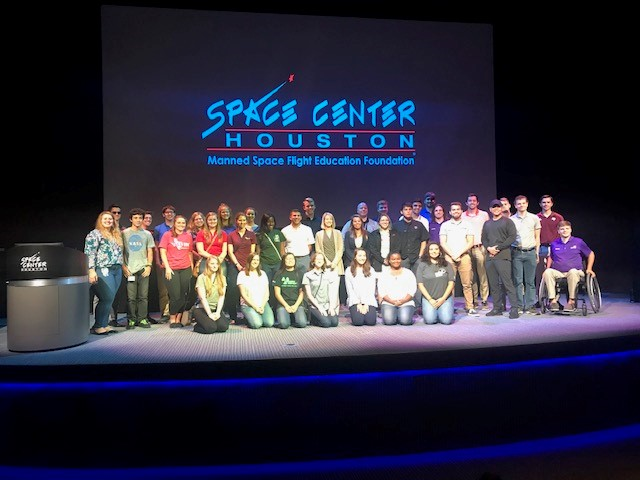Summer Students Get Parting Advice
After an invigorating summer gaining work experience at NASA’s Johnson Space Center, some of the outgoing interns attended a culminating event at Space Center Houston, Johnson’s official visitor center, with other students completing a summer tour with Houston Exponential.
Space Center Houston hosted a panel discussion for the group, with the panelists offering advice ranging from NASA career paths and STEM education to teamwork and favorite stories from the trenches of human space exploration.
Moderated by Space Center University Director Kaci Heins, the panel featured Dan Surber, International Space Station flight controller; Cheryl Slyter, technical manager for the Software, Robotics and Simulation Division within the Engineering Directorate; and Lauren Maples, a dive operations specialist at the Neutral Buoyancy Laboratory (NBL). The trio from NASA had an array of helpful advice for the next-generation workforce.

Image credit: NASA
Maples feels that working closely with NASA and aerospace gave her an edge in becoming an NBL diver.
“I attribute my knowledge and experience in the aerospace industry to Space Center Houston’s Education Department, as [that experience] allowed me to reach my goals,” Maples said. “I worked in the Space Center Houston Education Department from ages 19 to 25 with the Space U program. Space U immerses students in learning experiences tied to various areas of aerospace engineering, including scuba diving. I became scuba certified and began teaching the students basic scuba skills, and then the students would build a project underwater—similar to astronaut training at the NBL. It had been a longtime dream of mine to become a diver at the NBL. I reached my dream in 2015, and I’m humbled by it every day.”
Sometimes, though, roads less traveled still lead back to NASA. It did for Surber.
“I work in mission control, but I had a roundabout way of getting here,” Surber said. “Some people apply immediately after college and are lucky enough for this to be their first job. I put in some time as an active duty military officer while working on advanced degrees. The goal was always to end up here, but—I want to emphasize—that’s not the most efficient way to become a flight controller!”
Meanwhile, Slyter encouraged the interns to speak up to offer their own unique insight for NASA’s missions.
“Don’t be afraid to bring your new ideas to the projects you are working,” Slyter said. “You have a unique and valuable set of skills and perspectives. NASA needs fresh ways of looking at problems, and you can provide that.”
Surber echoed, “Spaceflight isn’t easy. It’s technically challenging, and you have new problems to solve every day. Working toward a STEM degree is very similar. You get the opportunity to solve unique problems, think critically and approach things from a different point of view. Flight operations requires all of those skills, and getting that exposure early in my academic career has helped me to embrace the kind of challenges that we face every day.”
In addition to the panel event, the Houston Exponential guests also visited other cutting-edge employers—like TIRR Memorial Hermann Research and Rehabilitation and DOW—to observe more STEM career opportunities in the Houston area.
However, for college graduates who want to end up at the best place to work in the federal government, sometimes a little more is wanted than just the requisite STEM foundation. The “right stuff” is always in high demand.
“Network with people,” Surber said. “Let them know how passionate you are about the space program. Work on design projects, become proficient with tools—basically anything to get your hands dirty. It will all pay dividends when you can add these things to your resume.”









